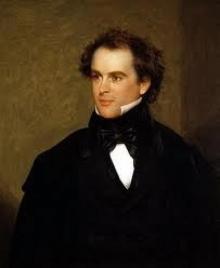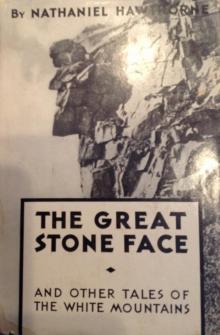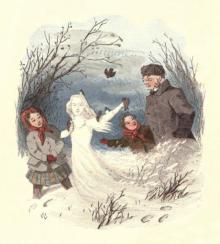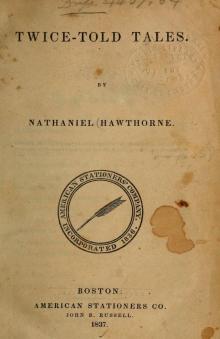- Home
- Nathaniel Hawthorne
Drowne's Wooden Image Page 2
Drowne's Wooden Image Read online
Page 2
``The same?'' answered another, who had arrived in town only the night before. ``Who do you mean? I see only a sea-captain in his shoregoing clothes, and a young lady in a foreign habit, with a bunch of beautiful flowers in her hat. On my word, she is as fair and bright a damsel as my eyes have looked on this many a day!''
``Yes; the same!--the very same!'' repeated the other. ``Drowne's wooden image has come to life!''
Here was a miracle indeed! Yet, illuminated by the sunshine, or darkened by the alternate shade of the houses, and with its garments fluttering lightly in the morning breeze, there passed the image along the street. It was exactly and minutely the shape, the garb, and the face which the towns-people had so recently thronged to see and admire. Not a rich flower upon her head, not a single leaf, but had had its prototype in Drowne's wooden workmanship, although now their fragile grace had become flexible, and was shaken by every footstep that the wearer made. The broad gold chain upon the neck was identical with the one represented on the image, and glistened with the motion imparted by the rise and fall of the bosom which it decorated. A real diamond sparkled on her finger. In her right hand she bore a pearl and ebony fan, which she flourished with a fantastic and bewitching coquetry, that was likewise expressed in all her movements as well as in the style of her beauty and the attire that so well harmonized with it. The face with its brilliant depth of complexion had the same piquancy of mirthful mischief that was fixed upon the countenance of the image, but which was here varied and continually shifting, yet always essentially the same, like the sunny gleam upon a bubbling fountain. On the whole, there was something so airy and yet so real in the figure, and withal so perfectly did it represent Drowne's image, that people knew not whether to suppose the magic wood etherealized into a spirit or warmed and softened into an actual woman.
``One thing is certain,'' muttered a Puritan of the old stamp, ``Drowne has sold himself to the devil; and doubtless this gay Captain Hunnewell is a party to the bargain.''
``And I,'' said a young man who overheard him, ``would almost consent to be the third victim, for the liberty of saluting those lovely lips.''
``And so would I,'' said Copley, the painter, ``for the privilege of taking her picture.''
The image, or the apparition, whichever it might be, still escorted by the bold captain, proceeded from Hanover Street through some of the cross lanes that make this portion of the town so intricate, to Ann Street, thence into Dock Square, and so downward to Drowne's shop, which stood just on the water's edge. The crowd still followed, gathering volume as it rolled along. Never had a modern miracle occurred in such broad daylight, nor in the presence of such a multitude of witnesses. The airy image, as if conscious that she was the object of the murmurs and disturbance that swelled behind her, appeared slightly vexed and flustered, yet still in a manner consistent with the light vivacity and sportive mischief that were written in her countenance. She was observed to flutter her fan with such vehement rapidity that the elaborate delicacy of its workmanship gave way, and it remained broken in her hand.
Arriving at Drowne's door, while the captain threw it open, the marvellous apparition paused an instant on the threshold, assuming the very attitude of the image, and casting over the crowd that glance of sunny coquetry which all remembered on the face of the oaken lady. She and her cavalier then disappeared.
``Ah!'' murmured the crowd, drawing a deep breath, as with one vast pair of lungs.
``The world looks darker now that she has vanished,'' said some of the young men.
But the aged, whose recollections dated as far back as witch times, shook their heads, and hinted that our forefathers would have thought it a pious deed to burn the daughter of the oak with fire.
``If she be other than a bubble of the elements,'' exclaimed Copley, ``I must look upon her face again.''
He accordingly entered the shop; and there, in her usual corner, stood the image, gazing at him, as it might seem, with the very same expression of mirthful mischief that had been the farewell look of the apparition when, but a moment before, she turned her face towards the crowd. The carver stood beside his creation mending the beautiful fan, which by some accident was broken in her hand. But there was no longer any motion in the lifelike image, nor any real woman in the workshop, nor even the witchcraft of a sunny shadow, that might have deluded people's eyes as it flitted along the street. Captain Hunnewell, too, had vanished. His hoarse sea-breezy tones, however, were audible on the other side of a door that opened upon the water.
``Sit down in the stern sheets, my lady,'' said the gallant captain. ``Come, bear a hand, you lubbers, and set us on board in the turning of a minute-glass.''
And then was heard the stroke of oars.
``Drowne,'' said Copley with a smile of intelligence, ``you have been a truly fortunate man. What painter or statuary ever had such a subject! No wonder that she inspired a genius into you, and first created the artist who afterwards created her image.''
Drowne looked at him with a visage that bore the traces of tears, but from which the light of imagination and sensibility, so recently illuminating it, had departed. He was again the mechanical carver that he had been known to be all his lifetime.
``I hardly understand what you mean, Mr. Copley,'' said he, putting his hand to his brow. ``This image! Can it have been my work? Well, I have wrought it in a kind of dream; and now that I am broad awake I must set about finishing yonder figure of Admiral Vernon.''
And forthwith he employed himself on the stolid countenance of one of his wooden progeny, and completed it in his own mechanical style, from which he was never known afterwards to deviate. He followed his business industriously for many years, acquired a competence, and in the latter part of his life attained to a dignified station in the church, being remembered in records and traditions as Deacon Drowne, the carver. One of his productions, an Indian chief, gilded all over, stood during the better part of a century on the cupola of the Province House, bedazzling the eyes of those who looked upward, like an angel of the sun. Another work of the good deacon's hand--a reduced likeness of his friend Captain Hunnewell, holding a telescope and quadrant--may be seen to this day, at the corner of Broad and State streets, serving in the useful capacity of sign to the shop of a nautical instrument maker. We know not how to account for the inferiority of this quaint old figure, as compared with the recorded excellence of the Oaken Lady, unless on the supposition that in every human spirit there is imagination, sensibility, creative power, genius, which, according to circumstances, may either be developed in this world, or shrouded in a mask of dulness until another state of being. To our friend Drowne there came a brief season of excitement, kindled by love. It rendered him a genius for that one occasion, but, quenched in disappointment, left him again the mechanical carver in wood, without the power even of appreciating the work that his own hands had wrought. Yet who can doubt that the very highest state to which a human spirit can attain, in its loftiest aspirations, is its truest and most natural state, and that Drowne was more consistent with himself when he wrought the admirable figure of the mysterious lady, than when he perpetrated a whole progeny of blockheads?
There was a rumor in Boston, about this period, that a young Portuguese lady of rank, on some occasion of political or domestic disquietude, had fled from her home in Fayal and put herself under the protection of Captain Hunnewell, on board of whose vessel, and at whose residence, she was sheltered until a change of affairs. This fair stranger must have been the original of Drowne's Wooden Image.
share-buttons">share

 The Scarlet Letter
The Scarlet Letter Young Goodman Brown : By Nathaniel Hawthorne - Illustrated
Young Goodman Brown : By Nathaniel Hawthorne - Illustrated The Birthmark
The Birthmark The Marble Faun; Or, The Romance of Monte Beni - Volume 1
The Marble Faun; Or, The Romance of Monte Beni - Volume 1 The Minister's Black Veil
The Minister's Black Veil The Great Stone Face, and Other Tales of the White Mountains
The Great Stone Face, and Other Tales of the White Mountains The House of the Seven Gables
The House of the Seven Gables The Snow Image
The Snow Image The Blithedale Romance
The Blithedale Romance Rappaccini's Daughter: By Nathaniel Hawthorne - Illustrated
Rappaccini's Daughter: By Nathaniel Hawthorne - Illustrated Twice-Told Tales
Twice-Told Tales Twice Told Tales
Twice Told Tales The Marble Faun; Or, The Romance of Monte Beni - Volume 2
The Marble Faun; Or, The Romance of Monte Beni - Volume 2_preview.jpg) Footprints on the Sea-Shore (From Twice Told Tales)
Footprints on the Sea-Shore (From Twice Told Tales) Main Street
Main Street_preview.jpg) The Seven Vagabonds (From Twice Told Tales)
The Seven Vagabonds (From Twice Told Tales) Fanshawe
Fanshawe Chippings with a Chisel
Chippings with a Chisel Selected Tales and Sketches
Selected Tales and Sketches Young Goodman Brown
Young Goodman Brown Roger Malvin's Burial
Roger Malvin's Burial The Prophetic Pictures
The Prophetic Pictures The Village Uncle
The Village Uncle Scarlet Letter (Barnes & Noble Classics Series)
Scarlet Letter (Barnes & Noble Classics Series) The Procession of Life
The Procession of Life Drowne's Wooden Image
Drowne's Wooden Image Hawthorne's Short Stories
Hawthorne's Short Stories My Kinsman, Major Molineux
My Kinsman, Major Molineux Legends of the Province House
Legends of the Province House Foot-Prints on the Sea-Shore
Foot-Prints on the Sea-Shore The Haunted Quack
The Haunted Quack Tanglewood Tales
Tanglewood Tales The Seven Vagabonds
The Seven Vagabonds Mosses from an Old Manse, Volume 2
Mosses from an Old Manse, Volume 2 The Canterbury Pilgrims
The Canterbury Pilgrims Wakefield
Wakefield The Gray Champion
The Gray Champion The White Old Maid
The White Old Maid The Snow-Image: A Childish Miracle
The Snow-Image: A Childish Miracle The Gentle Boy
The Gentle Boy Mr. Higginbotham's Catastrophe
Mr. Higginbotham's Catastrophe![The Threefold Destiny: A Fairy Legend, by Ashley Allen Royce [pseud.] Read online](http://i1.bookreadfree.com/i2/04/10/the_threefold_destiny_a_fairy_legend_by_ashley_allen_royce_pseud__preview.jpg) The Threefold Destiny: A Fairy Legend, by Ashley Allen Royce [pseud.]
The Threefold Destiny: A Fairy Legend, by Ashley Allen Royce [pseud.] Lady Eleanore`s Mantle
Lady Eleanore`s Mantle The Great Carbuncle
The Great Carbuncle The Portable Hawthorne (Penguin Classics)
The Portable Hawthorne (Penguin Classics) True Stories from History and Biography
True Stories from History and Biography